There is a popular saying; “the best survival knife is the knife you have on you.” It is true that in a real-life or death survival situation whatever knife you have with you is going to be the best knife available, even if it’s just a bread knife or a folding Swiss Army knife. As we prepare for a survival situation and practice our survival skills we have the luxury of choosing from a great range of fantastic products that will truly be a good survival knife rather than just something that will do the job.
When you choose a survival knife you will be selecting the knife you WANT to have in an emergency and then it’s up to you to make the relevant preparation to make sure you have it with you when you need it. For this reason, you will see a range of survival knife options in this top ten list from larger ‘one tool’ style knives which could be pressed to do work normally reserved for an axe or saw, and a few smaller options which may not be as powerful when it comes to chopping tasks but which you might more realistically carry with you and actually have at your disposal in an emergency or survival situation.
Whatever your choice may be, a knife is arguably the most vital tool for wilderness survival. It can help shelter you, help feed you and help protect you. It is the tool you use to create other tools. Tools that will help you survive.
Meet Our Winners


Ka-Bar BK-2 Becker Companion
The Ka-Bar BK-2 Becker Companion is arguably the best survival knife you can buy at the moment. Besides buying a top-end piece of gear, you’re also purchasing a reputation in knife-making that stretches generations.
Do I Really Need a Survival Knife?
Almost nobody leaves their house in the morning thinking: “Let me go out for a walk and survive. I’ll just grab the best survival knife I have and take it along.” Having to survive is almost without exception something that is required of you unexpectedly—typically stemming from a much more mundane or routine outing gone wrong.
This is when you’ll need to call on your skills to survive, and the knife you’ll be using is the one you have with you.
You may go camping or hiking and find yourself lost in the woods after walking to a waterfall somewhere on the map. Your car breaks down on a remote road with no mobile phone reception. A mountaineering trip gets interrupted when a massive storm suddenly rolls in, and there’s no time to get off the mountain. A hunting expedition meets with an unfortunate accident, and you find yourself hurt and unable to walk. A hurricane cuts your house off from all water, power, or food supplies for weeks.
What Makes a Knife a Good Survival Knife?
Knife design is a series of trade-offs, and it’s up to you to pick a knife that doesn’t trade off more valuable features for something that sounds “cool” but isn’t of much use. (read: “clever marketing”) You can allow your preferred knife design to be informed by situations that active soldiers may find themselves in during combat, and you never will. Understand that you may be trading off more essential features that you’ll need when you get snowed in at your campsite for two weeks.
No, the chances of you having to cut through the fuselage of an aircraft are slim. Yes, you may very well have to dig for roots or make a fire with just your knife.
Survival situations are, by definition, unpredictable. Because of that, survivalists, preppers, and knife manufacturers often dream up possible scenarios that are highly unlikely, though not impossible, for the average person to find themselves in.
Likely
- Build a shelter
- Make a fire
- Prepare food
- Chop wood
- Make other tools
- Build snares and traps
- Open food containers
- Hunt and prep meat
- Spear fish
- Dig for roots
- Pry open doors
- Dig holes
- Perform medical procedures
Unlikely
- Defend yourself
- Cut through aircraft fuselage
- Hack through a jungle
Never
- Throw it
- Shave
- Clean your Fingernails
- Open a Champagne bottle
- Fight off Zombies
What Size is the Right Size for a Survival Knife?
Survival knives come in all shapes and sizes, and there are several schools of thought on which form factor and size make for the best survival knife. You need to figure that out for yourself. Knives that are either too large or too small simply don’t fulfill the utility well. If we were to classify survival knife sizes based on blade size, I’d go with:
- Large: 5.5 – 7 inches
- Medium: 3.5 – 5.5 inches
- Small: Under 3.5 inches
In this guide, I recommend mostly “medium” sized knives. My main reason for this is that I think medium-sized knives tick almost all the boxes that a large format knife does, yet you are more likely to have them with you during a survival situation. Few people carry around a huge knife. Larger knives may be better choppers, but you can process wood with minimal additional effort with a medium-sized knife. I’d recommend upgrading your survival and bushcraft skills rather than having to need a larger knife.
I did include knives that would be considered larger survival knives by my criteria above, as I think they merit consideration as survival tools.
I’m not recommending small knives, and I am not recommending huge blades. If that happens to be all you have with you, work with it! As you read through this article and consider what role a survival knife fulfills, it should become apparent why I would not deliberately plan for those to be my only knife when confronted by a survival situation.
What About Weight?
Again, same as with the size of the knife, the weight plays a significant role in determining the likelihood of you having a specific knife with you when you need it. Too heavy, and chances are you will opt for a different knife when setting out on an extended hike or camping trip, just to preserve weight. That said, it helps to have a knife with substance for chopping wood, processing meat, and digging holes. One that won’t break when you start roughing it a bit.
The weight of a knife is driven primarily by the thickness and width of the blade and tang. Very seldom nowadays will handle material have a significant impact on weight. It sometimes does, but not often. A great example of this is the EESE range of knives. The ESEE 6P, which made it onto our list as a large knife, has a total length of 11.75 inches and weighs 12 oz. The ESEE 5P is slightly smaller at 11 inches but weighs 16 oz! They have the same handle. The difference? The 6P has a 6.35mm thick blade, and the 5P has a 4.7mm blade.
The graph below shows how the different knives that made it onto our list compare in size. I’ve also added a line to show the weight of each of the knives.
What To Look For In A Survival Knife?
- Fixed blade
- High Carbon Steel
- Full tang
- Synthetic handle
- Plain Edge
- Flat or Convex grind
- Drop Point or Spear Tip
- Protruding tang pommel
- Lanyard holes
I discuss all of these features in more detail in our Buyers Guide at the bottom of this article. For now, as you read through the reviews below, just keep them in mind.
How to proceed?
We are going to jump right in and show you the survival knives we selected for our top list. However, if this is your first time buying a survival knife, or if you just want to immerse yourself and make an informed purchase decision we strongly recommend that you jump over to our Survival Knife Buyers Guide and the end of this article. It’s not a short read but is intended to be the ultimate survival knife buyers guide and you’ll be glad you did.
The 10 Best Survival Knives
1. Ka-Bar BK-2 Becker Companion

Steel: 1095 Cro-Van
Length: 10.75 in
Weight: 14.88 oz
| Steel: | 1095 Cro-Van |
| Blade Length (in): | 5.25 |
| Blade Thickness (mm): | 6.6 |
| Overall Length (in): | 10.75 |
| Overall Weight (oz) | 14.88 |
| Blade Shape: | Drop Point |
| Grind: | Flat |
| Edge: | Plain |
| Hardness (HRC): | 56-58 |
| Handle Material: | Zytel |
| Protruding Pommel: | Yes |
| Lanyard Hole: | Yes |
| Sheath: | Polyester |
The Ka-Bar BK-2 Becker Companion gets my nod for the knife I’d like to have with me if I could only have one knife in a survival situation. The BK-2 checks all of the boxes in our list of essential features we’d like to see in a handy survival knife. Designed by Ethan Becker, the founder of the Becker Knife and Tool Corporation, the BK-2 builds on an ethos of great knife-making that stretches back to its beginnings in the 1980s.
The Blade
The BK-2 is made of 1095 Cro-Van steel. Chromium and Vanadium improve the wearability of the standard 1095 carbon steel. The Ka-Bar BK-2 is a full tang knife with a 5.25” blade and a 10.75” overall length. The blade thickness is 0.26” (6.6 mm), which is the thickest blade of all the knives in our selection. This chunky blade, combined with the width, contributes to the substantial 14.88 oz weight of the knife.
It’s a pretty heavy knife, and those with a preference for lighter-weight survival knives may see this as overkill, but many survival tasks benefit from a heavy, strong blade. You can dig roots and holes to your heart’s content. You’re not breaking this blade. Though it’s a medium-sized knife, the blade weight adds some utility, usually only found in larger “choppers.” Processing wood is a pleasure.
The simple drop point tip, flat grind, and plain edge check a few additional boxes that I think most of the best survival knives share. Remember, 1095 is carbon steel and will be more prone to rusting and corrosion than stainless steel, but it is sensible for a survival knife. It is a tried and tested steel that holds its edge well and is easy to sharpen.
The Handle
The BK-2 handle is made from synthetic Zytel glass-reinforced nylon by Dupont. It is suitably tough and hard-wearing to fit the design ethos for this knife. The ergonomics is very comfortable with no hot spots and easily accommodate large hands. While the handle is shaped, it is not nearly as prescriptive as the finger grooves on the Schrade.
The full tang protrudes at the back and has a flat finish, which we love. A protruding tang simply means your handle will not be taking a beating as you baton or hammer away on the back. The flat pommel makes for a more functional contact area than a pointy “glass-breaker,” which does little but destroy your baton.
The Sheath
The Ka-Bar BK-2 Becker Companion ships with black hardshell nylon heavy-duty polyester sheath. The sheath is MOLLE compatible, and while it may look somewhat understated and underwhelming at first, it’s pretty cleverly designed. The knife locks in place in the sheathe. To release, press down with your thumb on the designated area at the back. This safety lock feature ensures that your knife stays securely in place and prevents it from falling out and getting lost.
Conclusion
The Ka-Bar BK-2 Becker Companion is arguably the best survival knife you can buy at the moment. Yes, it’s a bit on the heavy side, but that has its advantages. I cannot think of many survival scenarios where you’d regret having this by your side. Besides buying a top-end piece of gear, you’re also purchasing a reputation in knife-making that stretches generations.
2. ESEE Knives 6P Fixed Blade Knife
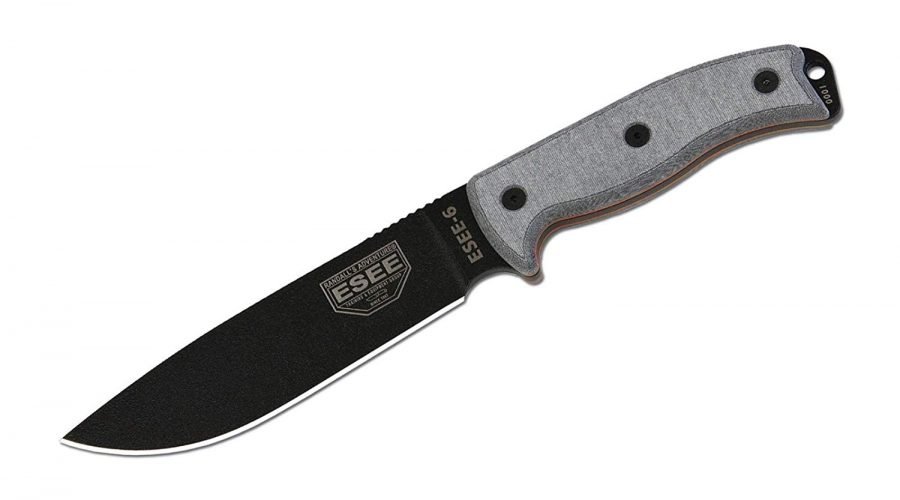
Steel: 1095 Carbon
Length: 11.75 in
Weight: 12 oz
| Steel: | 1095 Carbon |
| Blade Length (in): | 6.5 |
| Blade Thickness (mm): | 4.7 |
| Overall Length (in): | 11.75 |
| Overall Weight (oz) | 12 |
| Blade Shape: | Drop Point |
| Grind: | Flat |
| Edge: | Plain |
| Hardness (HRC): | 55-57 |
| Handle Material: | Micarta Canvas |
| Protruding Pommel: | Yes |
| Lanyard Hole: | Yes |
| Sheath: | Molded Polymer |
The ESEE 6P is a fantastic addition to the ESEE line of fixed blade knives. It is the second-largest knife – after the Schrade SCHF9 – in our selection of survival knives, and that’s intentional. ESEE designed this to be a large format knife. With the 5P and the 4P covering off the smaller format spectrum for ESEE. The 6P comes in various color schemes ranging from the typical black powder coated blade with a grey handle to a “dark earth” blade with a green handle. It is also available in a “venom green” blade with a neon orange-red handle. It is probably the most colorful survival knife ever made!
The Blade
Like the Ka-Bar BK 2, the ESEE 6P blade is 1095 high carbon steel. Again, this is strong steel with great edge retention and is easy to sharpen, but because it’s not stainless steel is slightly more susceptible to corrosion and rust. So lubricate!
The ESEE 6P has a total length of 11.75” and sports a 6.6” blade that’s 0.185” (4.7 mm) thick. This puts it very much in the “large survival knife” category. Even with that added length, it weighs in at 12 oz, which is 2.88 oz less than the BK-2 above, so the knife is more than manageable even to people with smaller hands. The knife has a finger choil which we think is a wasted feature on most knives. Yes, we know there may be times when you feel you need to slip one finger off the handle and onto the blade but seriously, keep your damn hand on the handle. The ESEE 6P is a well-balanced knife, and you just don’t need to add that potential injury risk to get the job done.
The ESEE 6P has a simple drop point blade, a plain edge, and a flat grind, just how we like our survival knives. There’s some “jimping” at the spine of the blade to increase thumb grip. It holds its edge as well as you can expect from forged 1095 steel and is easy to sharpen. All of this just makes for a practical, well-though-out blade for a survival knife.
The Handle
Like quite a few other survival knives, ESEE opted for a Micarta linen handle. Again, a sensible decision as Micarta is tough and doesn’t get slippery when wet. It tends to grip even better. The pommel is rounded and protrudes from the handle, so you can lay in with a baton and know that you won’t be damaging it on a sharp “glass breaker.” At the same time, you will not be putting strain on the handle itself. The lanyard hole is in the protruding part of the pommel and does not go through the Micarta.
The Sheath
The ESEE 6P comes with molded polymer sheath with a clip plate. It is MOLLE compatible, which is great, but as with the BK-2, the sheath is somewhat underwhelming. The clip is removable, which is good as I just don’t see myself carrying a knife of this size and weight by a clip only. ESEE can drop that feature.
Conclusion
The ESEE 6P is a very capable knife, and I couldn’t think of a single reason I’d regret having this with me in a survival situation. It is well balanced, and you can use it for anything from chopping wood, chopping onions, and everything in-between.
But what about the ESEE 5P?
Glad you asked! I like medium-sized survival knives, so when putting together this list, I was tempted to run with the 5P. I love that knife. The two main reasons I’m recommending the 6P over the 5P as a survival knife are:
Weight – the 5P is only 3/4 “ shorter than the 6P but weights an incredible 4 oz more! All of that comes from the 0.25” thick blade, vs the 0.185” of the 6P.
Sharp “glass breaker” pommel – The 5P has a tapered pommel, which I have never seen much use for in non-tactical situations. A sharp pommel does more damage than good. You can break glass with a rounded or flat pommel almost as quickly, but a pointed pommel just damages whatever other tools you use to hammer on the back of the knife.
If you don’t care about the pommel and like a heavier survival knife – and there’s merit to that – then you should seriously consider the ESEE 5P as well.
3. Schrade SCHF9
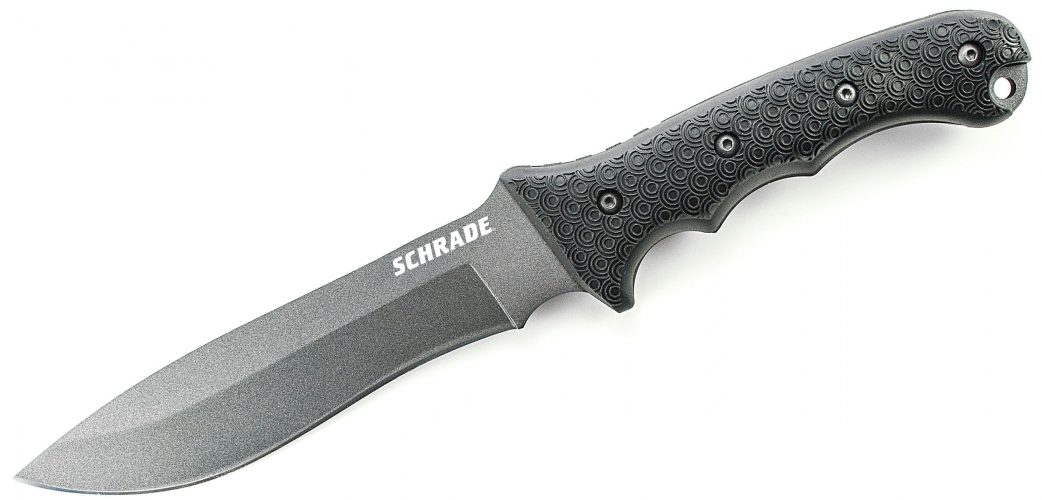
Steel: 1095 Carbon
Length: 12.10 in
Weight: 15.70 oz
| Steel: | 1095 Carbon |
| Blade Length (in): | 6.4 |
| Blade Thickness (mm): | 6 |
| Overall Length (in): | 12.10 |
| Overall Weight (oz) | 15.70 |
| Blade Shape: | Kukri Point |
| Grind: | Flat |
| Edge: | Plain |
| Hardness (HRC): | 56-58 |
| Handle Material: | Thermoplastic Elastomer |
| Protruding Pommel: | Yes |
| Lanyard Hole: | Yes |
| Sheath: | Cordura |
The Schrade SCHF9 is another larger fixed blade survival knife. It is the “largest” survival knife on our list and a perfect choice for the budget-conscious. Schrade knives are very robust, I have used several of their frontier range, and they are handy backwood survival knives. The slight recurve shape of this blade, sometimes described as a Kukri tip, makes it excellent for slicing tasks, although slightly more challenging to sharpen. The heavy point of the knife moves the point of balance forward and makes it useful for light chopping tasks, which might be necessary for shelter building and brush clearance in a survival situation.
The Blade
Like the ESEE 6P and the Ka-Bar BK 2, the Schrade SCHF9 blade is made from 1095 high carbon steel. Again, relatively easy to sharpen and holds an edge well but needs to be maintained to prevent rust and corrosion. It remains a sensible choice for survival knives. The blade is 6.6” long and the overall knife measures 12.10”, comfortably making it the largest knife on our list of top-end survival knives. The blade is 0.236” (6 mm) thick, and the full-tang design contributes to an overall weight of 15.70 oz. Again, making it not only the largest but also the heaviest knife to be featured here.
Schrade’s series of survival knives feature a plain edge and hollow grinds that are not my favorite grind for survival knives. They can be pretty fragile, especially if you plan on using them for chopping, which this knife, with its size and weight, would be particularly suited for. It’s an excellent grind for meat preparation and processing game that you might have trapped or caught in a survival situation, but they are not the most robust grinds.
The Handle
The black, ring-textured thermoplastic elastomer handle on the Shrade is probably my least favorite of the knives here. With materials like Micarta readily available, thermoplastic is just not the best choice if you’re hoping to add a handle to a large knife that will not slip when wet. The ring texture is supposed to help reduce slippage, but it’s still not the most stable grip in wet conditions.
Prominent finger grooves along the knife handle make the grip very “prescriptive” and don’t show much regard for different hand sizes. Is this another attempt at stabilizing a rather large knife with a slippery handle? And then, of course, they added thumb jimping and a colossal finger choil. You know my sentiments about finger choils by now.
The Sheath
The sheath that comes with the Schrade SCHF9 is made from Cordura that fits comfortably on your belt. It also sports a removable pouch for EDC. Some may find this feature useful, while others may see it as redundant. The sheath is n more stable on your hip than that of the Ka-Bar BK 2. It is MOLLe compatible features a quick latching system that allows you to attach to remove the sheath without loosening your belt, which is quite nice. Overall a pretty good sheath with some cool features not seen in many other survival knife systems.
Conclusion
The Shardae SCHF9 is a beast of a knife. I think it’s good value for money, but I wish Shrade would rethink the handle design. Regardless, if you’re looking for a survival knife that borders on being a full-blown chopper and like some bulk to your blade, then this is undoubtedly a knife worth considering.
4. Fallkniven A1
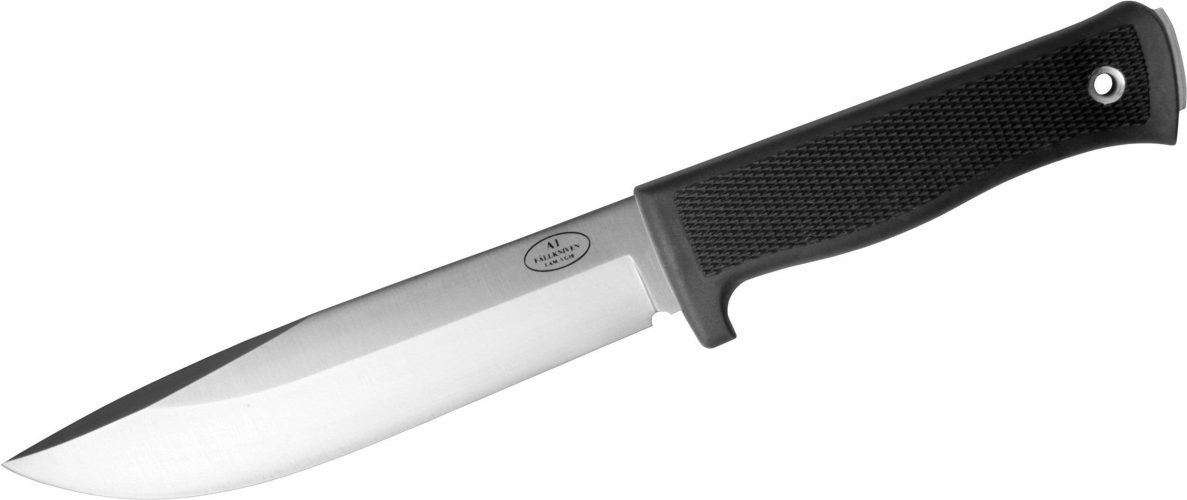
Steel: Lam.VG 10
Length: 12.10 in
Weight: 15.70 oz
| Steel: | Lam.VG10 |
| Blade Length (in): | 6.3 |
| Blade Thickness (mm): | 6 |
| Overall Length (in): | 11.02 |
| Overall Weight (oz) | 11.25 |
| Blade Shape: | Drop Point |
| Grind: | Convex |
| Edge: | Plain |
| Hardness (HRC): | 59 |
| Handle Material: | Kraton |
| Protruding Pommel: | Yes |
| Lanyard Hole: | Yes |
| Sheath: | Zytel / Leather |
Before I even start, let me make it clear, I love Fallkniven knives! The Swedish knife-maker makes some of the most beautifully and practically designed knives available on the market. Understated but functional to a fault, and the Fallkniven A1 survival knife is no exception. There is a “Pro” version of this knife available which, though beautiful, gives you very little additional functionality for a lot more money. Just stick to the standard A1.
The Blade
Like its smaller counterpart Th F1, the Fallkniven A1 blade uses laminate steel featuring 420J outer cladding with a VG-10 core. VG-10 is more brittle than some carbon steels like 1095 on this list but has the benefit of being stainless steel that is less susceptible to rust or corrosion. The high-end stainless steel holds an edge well and makes the A1 is happy to perform almost any cutting task you can conjure up wonderfully.
The blade is 6.3” long and 0.236” (6 mm) thick. The knife is 11.02” long and weighs 11.25 oz placing it firmly in our larger survival knife group.
The Fallkniven A1 has a simple drop point design with a plain edge. Fallkniven, unfortunately, and this is one of my few complaints, opted for a convex grind which is just not the best grind for a hard-working survival knife. Excellent for cutting, it is slightly more challenging to sharpen, and the added strength from the convex blade doesn’t add enough value as opposed to a simple flat grind. That being said, it would not deter me from taking this into any survival situation on any day.
The Handle
The handle of the Fallkniven A1 builds on an ethos of simplistic functionality. The handle is made of Kraton, which is a hard-wearing semi-rubbery high-density polymer. The handle design is functional, and while some may lament the lack of finger notches and more pronounced grip design, I love this less authoritarian approach. The knife is well balanced and super comfortable and doesn’t form any hot spots, nor tire your hand from performing even the heaviest chopping tasks over a prolonged period.
Fallkniven was kind enough to include a protruding pommel to protect your handle from any hammering actions on the back of the knife.
The Sheath
When buying a Fallkinven A1, you can choose from a Zytel polymer sheath or a classic leather sheath. Both have their pros and cons, and my guess is it will come down to personal choice and how you plan to use the knife when making this decision. It’s up to you. Both these sheaths hold the blade secure and stable. I also love the fact that Fallkniven makes a sheath available for lefties! Nice touch.
Conclusion
The Fallkniven A1 is a deliberately understated but highly capable survival knife. No, it will not look as flashy or “aggressive” as some of the other knives on this list, but if you know what you’re looking for and understand the nuances of good knife design, this should be very high up on your list to consider.
5. Cold Steel SRK Survival Rescue Fixed Blade Knife
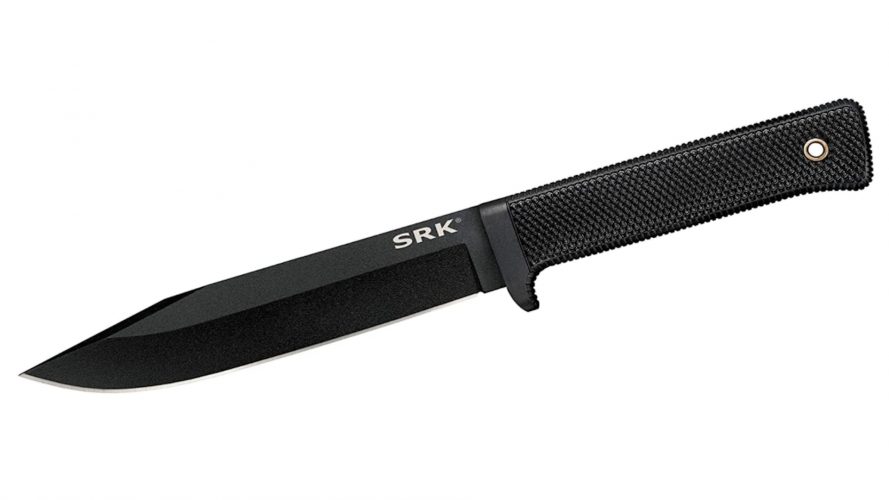
Steel: SK-5 Carbon
Length: 10.75 in
Weight: 7.90 oz
| Steel: | SK-5 Carbon |
| Blade Length (in): | 6 |
| Blade Thickness (mm): | 5 |
| Overall Length (in): | 10.75 |
| Overall Weight (oz) | 7.90 |
| Blade Shape: | Clip Point |
| Grind: | Hollow |
| Edge: | Plain |
| Hardness (HRC): | 60 |
| Handle Material: | Kray-EX |
| Protruding Pommel: | No |
| Lanyard Hole: | Yes |
| Sheath: | Secure-EX |
The Cold Steel SRK prides itself on being the standard-issue knife for the Navy SEALS for their BUDS – or Basic Underwater Demolition training. It is very much a knife designed with the military and tactical applications front-of-mind, but despite, or maybe because of that still makes for a pretty good survival knife.
The Blade
The Cold Steel SRK is made from SK-5 carbon steel. SK-5 is a hard carbon steel, around 65 HRC, giving it excellent edge retention but making it somewhat more difficult to sharpen. Hard steels are generally more brittle, so be careful when hammering it with a baton or subduing it to other impact tasks.
The blade is 6” long and 0.197” (5 mm) thick. The overall length of the SRK is 10.75”, and it weighs only 7.9 oz, which is pretty impressive for a knife this size. The lighter design makes sense though, if you consider that this is a knife intended for and often used by special forces swimmers, where every ounce of weight matters.
The Cold Steel SRK has a plain edge, convex grind, and a clip point design. Both the clip point and convex grind is not my first choice for a survival knife. For a tactical knife that has to be very sharp and can pierce or stab, it works.
The Handle
If you thought the handle design on the Fallkniven A1 wasn’t pronounced enough, then wait till you see the SRK! The handle is made of Kray-Ex, which is a tough-wearing rubberized material. It is textured and feels comfortable in hand, and will not slip no matter how wet you get it. Remember, it is intended for underwater use. The handle is entirely flat at the top with almost no finger or hand curves. While this may seem odd, this knife is often used with gloves, which favors a simple straight handle design.
The full tang is completely covered on top and below the handle and at the pommel. This is an intentional design feature to reduce the possibility of electric shock as Special Operations soldiers may have to use this knife to cut through electric wires.
The Sheath
The Cold Steel SRK Survival Rescue knife comes with a molded Secure-Ex sheath. The blade fits snugly into the sheath and is secured with a nylon loop to the belt. The sheath is, of course, MOLLE compatible. The molded polymer sheath is an interesting choice of material for a knife, where most of the compromises seem to favor a tactical knife. Hard-shell polymers are pretty noisy when the blade is extracted, not something you want in a covert situation.
Conclusion
As I said before, knife design is a series of trade-offs, and in the case of the Cold Steel SRK, those trade-offs favor a more tactical utility. It remains an excellent survival knife, and it’s hard to argue that a product that’s good enough for a Navy SEAL is not good enough for you. In the end, if you consider it purely on whether it is the best survival knife, it does end up being a bit of a “jack of all but master of none.”
6. Gerber LMF II Survival Knife
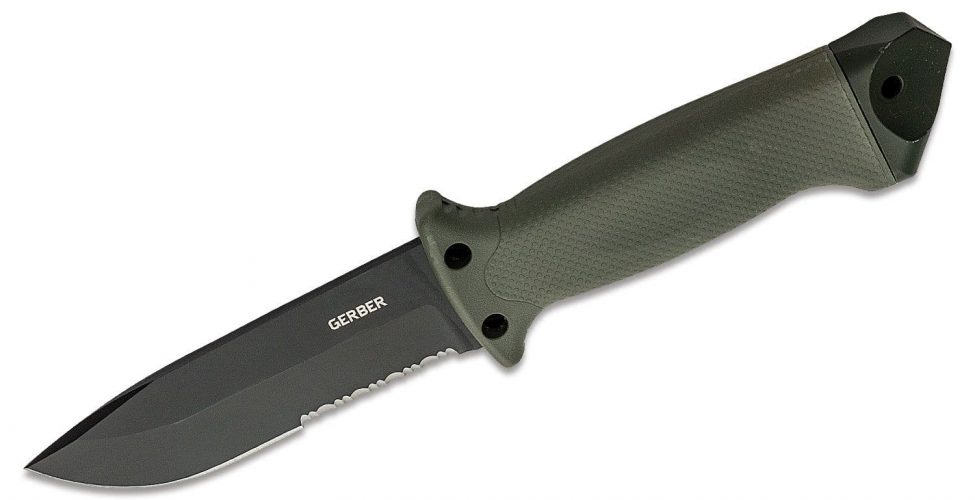
Steel: 420HC Stainless
Length: 10.59 in
Weight: 11.67 oz
| Steel: | 420HC Stainless |
| Blade Length (in): | 4.84 |
| Blade Thickness (mm): | 4.70 |
| Overall Length (in): | 10.59 |
| Overall Weight (oz) | 11.67 |
| Blade Shape: | Drop Point |
| Grind: | Sabre |
| Edge: | Partially Serrated |
| Hardness (HRC): | 58 |
| Handle Material: | Glass-Reinforced Nylon |
| Protruding Pommel: | No |
| Lanyard Hole: | Yes |
| Sheath: | Nylon |
Like the ColdSteel SRK, the Gerber LMF II was designed with the military in mind. It was originally intended to be used to help free a down aircrew from their aircraft. The LMF II is a very robust knife that has garnered a fantastic reputation. From a survival perspective, it is definitely geared towards military survival and rescue scenarios. It is an excellent tool in urban survival situations yet remains a very capably backwoods and wilderness survival knife.
The Blade
Gerber settled for 420HC Stainless steel for the blade on the LMF II. While not high-end stainless steel, it is pretty tough yet pliable, making it a good choice for a survival knife. It is tough enough to withstand almost any beating you can lay down. Feel free to chop away. At the same time, it is relatively easy to sharpen like a good kitchen knife. It’s not my favorite steel for a survival knife, but it certainly works.
The blade is 4.84” long and the overall knife 10.59”, making it a medium-sized fixed blade survival knife. The blade on the Gerber LMF II is 0.185” (4.7 mm) thick, and it weighs 11.67 oz.
You can describe the Gerber LMF II as an “almost full” tang (more on that later) knife. It has a drop point blade with a saber grind and a partially serrated edge. The serrated edge is undoubtedly intended to assist in cutting through objects like the fuselage of an aircraft. It does eat through sticks and branches but is not my favorite feature for a survival knife simply because it is so much harder to sharpen and keep sharp.
The Handle
The handle on the Gerber LMF II is made from glass-reinforced Nylon. Jeff Freeman, who led the design team for this knife obviously spent a lot of time thinking about the handle. As mentioned before, the knife’s tang does not extend to the back, and it is disconnected from the pommel. This reduces the chance of electric shock when cutting through electric wites (of which there is a lot in an aircraft’s fuselage!) The rear lanyard hole doesn’t pass through the steel either, for the same reason.
Two additional lashing holes at the top and bottom of the handle are a great addition when you need to convert your knife to a spear. One of my few complaints about the kife is the pointy glass-breaker pommel. I can see how this may be useful to hammer with in an attempt to break out of a downed plane, but a flat pommel makes more sense in almost all other scenarios.
The Sheath
The Gerber LMF II comes with a smartly designed nylon sheath that you can wear with either a belt strap or two leg strap options. Both work beautifully. The sheath is entirely MOLLE compatible. Gerber has added a built-in knife sharpener to the sheath, which is brilliant because this knife is more complicated to sharpen due to the serrated edge. Nice touch.
Conclusion
The Gerber LMF II is probably the most feature-loaded knife system on our list. Gerber made some obvious trade-offs with a specific military application in mind, but there’s no arguing that this is an excellent survival knife. Gerber is a reputable brand in the knife-making world, and while they have a range of knives that would be suitable to carry in a survival situation, the LMF II would be my choice.
7. Gerber Bear Grylls Ultimate Pro Knife
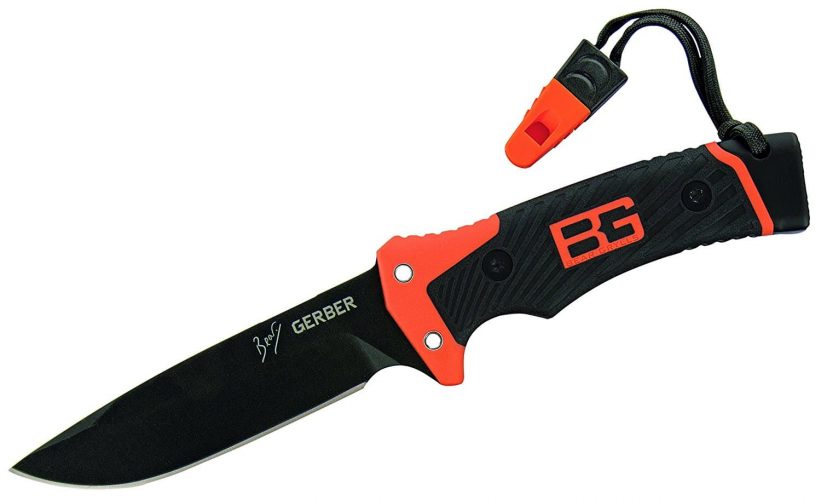
Steel: 9CR19M0V Carbon
Length: 10 in
Weight: 11.20 oz
| Steel: | 9CR19M0V Carbon |
| Blade Length (in): | 4.80 |
| Blade Thickness (mm): | 4.70 |
| Overall Length (in): | 10 |
| Overall Weight (oz) | 11.20 |
| Blade Shape: | Drop Point |
| Grind: | Hollow |
| Edge: | Plain |
| Hardness (HRC): | 58-60 |
| Handle Material: | TPE Overmold |
| Protruding Pommel: | No |
| Lanyard Hole: | Yes |
| Sheath: | Nylon |
The Gerber Bear Grylls Ultimate Pro Knife is a collaboration between Gerber and survivalist TV personality Bear Grylls. While I’m no big fan of Mr. Grylls’s shows, I think this is a knife worthy of inclusion on this list. Granted, it comes with some silly bells and whistles (literally!) that were probably more important to the marketing department of the Bear Grylls than the designers at Gerber. Still, if you look beyond that, you have a credible fixed blade survival knife.
The Blade
The Gerber Bear Grylls survival knife uses 9CR19MoV high carbon stainless steel. It’s a step up from the 7Cr17MoV used in the original Bear Grylls knife and a solid choice for a survival knife. It has pretty similar HRC comparable characteristics to AUS-8, but it has a lower price-point.
The blade is 4.8” long and 0.185” (4.7 mm) thick. The entire tool is 10” and weighs in at 11.2 oz. The Gerber Bear Grylls has a simple drop point design and a plain edge, a sensible choice for a survival knife. The hollow grind, on the other hand, is not our favorite grind. Hollow grinds are just too thin at the cutting edge for some of the rough taste that a survival knife will get subjected to. Yes, you can get this blade sharp as hell, slice onions and tomatoes to your heart’s content, but with a more brittle stainless steel and a hollow grind, you’ll have to be careful when starting to use the knife to perform hard-wearing tasks like chopping wood and building a shelter.
The designers once again couldn’t resist the temptation to add a finger choil so you can choke the knife when needed, but really, grip the handle, not the blade.
The Handle
The handle on the Gerber Bear Grylls is well designed and arguably one of the most comfortable handles of all the knives on this list! It is made from TPE Overmold, which is a texturized rubber compound. It is hard-wearing and feels solid in your hand. It does not slip at all when wet, and it just feels like a knife you could work with for hours without building up hot spots or fatigue.
The pommel covers the tang at the back, which I think is a pity as you have to beat down on your handle when hammering the knife from behind, but it’s still a solid flat pommel. As with all other knives, it has a lanyard hole in the back, and in this case, it ships with an attached lanyard and an emergency whistle (I told you so!).
Like the Gerber LMF II, the Gerber Bear Grylls has two additional lashing holes, which significantly aids in creating a spear or tying the knife down securely for any other purpose. A valuable but straightforward additional feature to any survival knife, in my opinion.
The Sheath
The sheath of the Gerber Bear Grylls Ultimate Pro is made from almost indestructible nylon. Unsurprisingly, it incorporates a slew of additional features. Most of them are actually pretty well-thought-out. Like the Morakniv Bushcrafter, there’s a ferrocerium rod that strikes against the back of the blade. The diamond sharpener built into the sheath works well, almost making you wonder why more manufacturers haven’t included this feature yet.
On the other hand, there’s also a small library of land and sea rescue instructions and a fold-out leaflet with Bear Gryll’s survival priorities that the marketing department probably added.
Conclusion
The Gerber Bear Grylls Ultimate Pro exceeded my expectations. It is a well-balanced knife that will be more than capable of helping you through the most gnarly survival situations you can imagine. This knife has the most optimal dimensions – blade length, overall length, blade thickness – of any survival knife on this list. Don’t just ignore it because it is manufactured in China. This knife merits consideration.
8. Benchmade – Bushcrafter 162
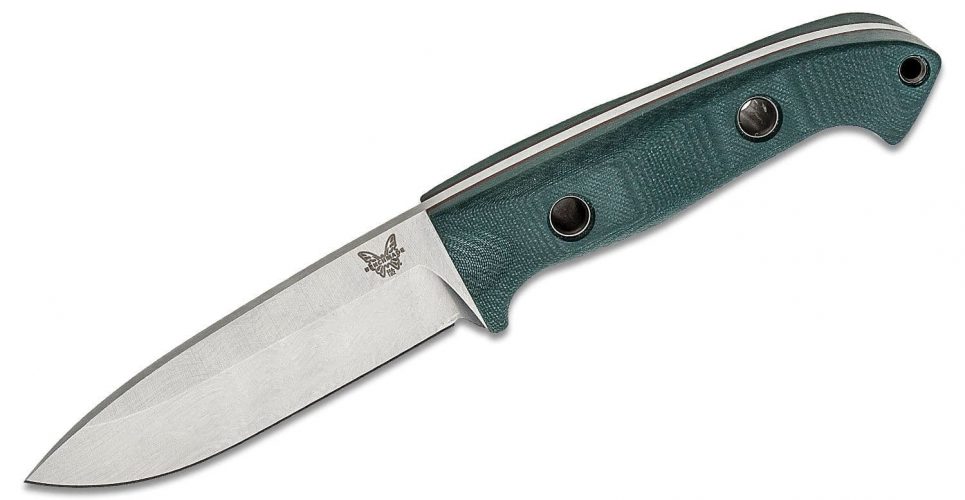
Steel: CPM-S30V
Length: 9.15 in
Weight: 7.72 oz
| Steel: | CPM-S30V |
| Blade Length (in): | 4.40 |
| Blade Thickness (mm): | 4.17 |
| Overall Length (in): | 9.15 |
| Overall Weight (oz) | 7.72 |
| Blade Shape: | Drop Point |
| Grind: | Flat |
| Edge: | Plain |
| Hardness (HRC): | 58-60 |
| Handle Material: | G-10 |
| Protruding Pommel: | No |
| Lanyard Hole: | Yes |
| Sheath: | Full-Grain Buckskin Leather |
If there was a prize for the most beautiful survival knife, the Benchmade Bushcrafter 162 would ship with a tiara. Don’t be fooled by its beautiful design and immaculate attention to detail though. This knife comes to you from Benchmade. You know it’s going to be functional and made to the highest standards. The Bushcrafter is a modern take on a survival knife, and it excels in all the traditional functions you would typically expect a survival or bushcraft knife to perform.
The Blade
The blade is a traditional drop point with a flat grind. Perfect for this type of knife. Benchmade opted for CPM-S30V stainless steel for the blade. If you decide to move away from high-carbon steels and use stainless steel, this is an excellent choice. You get the typical benefits of stainless steel – lower maintenance, higher corrosion resistance, and hardness. Yes, it takes a little more effort to sharpen, but it will hold that edge longer than carbon. The entire blade is 4.4” long and 4.17mm thick.
The knife from pommel to tip is 9.15” long and weighs 7.72oz.
The Handle
The handle of the Buschcrafter 162 steals the show when it comes to aesthetics. It is constructed from G10, a highly durable resin-soaked fiberglass that doesn’t allow any form of moisture penetration and holds up under a broad spectrum of climate temperatures.
If you’re adamant about natural colors, you can get the handle in a Desert Sand finish. Still, I think the original green handle with red inlays against the tang is stunning.
The handle is well designed with some suggested finger placing towards the front on the sides that may leave some wondering; “Why?” Once you grab the handle and shift it around in your hand into different holds as might be required for various tasks, you quickly learn that the additional finger placement options are welcome without being distracting when not being used.
The handle rounds up nicely to both ends allowing for a firm grip and ensuring your hand doesn’t slip in either direction when the tool is taxed with heavier work.
The Sheath
Also included on the edge of the sheath is a pocket tube for fire steel. The knife doesn’t ship with ferrocerium rod, but there are many options on the market that will fit this loop perfectly. Use the lanyard hole to secure your rod. The back of the Buschcrafter makes for a great striking surface to get that fire going.
Conclusion
The Benchmade Bushcrafter 162 could be considered the “high-end” option of all the knives listed here. Yes, it is more expensive than some other knives here, but you get what you pay for. It is called a “Bushcrafter” and could arguably be an almost perfect bushcraft knife, but the combination of functionality and style makes it a highly capable survival knife. It is one of those knives you just want to carry with you whenever you leave the tent, which makes it the knife you may very well have with you when an emergency arises. I can’t think of any reason you’d regret that.
9. Morakniv Bushcraft Carbon Steel Survival Knife

Steel: Carbon Steel
Length: 9.10 in
Weight: 5.40 oz
| Steel: | Carbon Steel |
| Blade Length (in): | 4.30 |
| Blade Thickness (mm): | 3.20 |
| Overall Length (in): | 9.10 |
| Overall Weight (oz) | 5.40 |
| Blade Shape: | Drop Point |
| Grind: | Scandi |
| Edge: | Plain |
| Hardness (HRC): | 56-58 |
| Handle Material: | Synthetic & Rubber |
| Protruding Pommel: | Yes |
| Lanyard Hole: | No |
| Sheath: | Plastic |
I can hear half of you screaming, “Finally!” and the other half, “A Mora is NOT a survival knife!” Everybody, please calm down. The Swedish knife manufacturer Morakniv has been making knives since 1912. Outside the world of knife-aficionados, they are probably best known for the Morakniv Companion. This small but well-designed little knife has become a staple in many camping and outdoor kits. It has amassed a small army of believers across the globe and a fair number of skeptics. Regardless of what you might think, and knife that can score a 4.8/5 on Amazon, from more than 17,000 reviews deserves some respect.
As a survival knife, the Morakniv Companion always fell short in quite a few design parameters. Enter the Morakniv Bushcraft Carbon Steel Survival Knife. Again, not unlike the Benchmade Bushcrafter, this is a pretty exceptional bushcraft knife that can double as a survival knife.
The Blade
The blade of the Moraknive Bushcrafter is made from carbon steel, 4.3” long and 3,2mm thick. The original Companion has a blade of similar size, but it is only 2.1mm thick. This is probably the most significant difference between the two knives. While 3.2mm is still on the thin side for a survival knife, it changes the feel of the knife completely. Looking down on your knife, it doesn’t feel like you’re trying to chop wood with a utility knife anymore. There’s just enough bulk to install some confidence in being able to execute more demanding tasks.
The Bushcrafter sports a full-tang design with a practical drop point and a scandi grind. (of course) The blade is covered with a black powder coating to make it a bit less reflective. The coating on my knife has started coming off. That has more to do with the fact that I use this as a workhorse, and I confess to some pretty rough and fast sharpening.
Like any other carbon steel, and maybe a bit more so than others, this steel is prone to rust, so be sure to apply a thin layer of oil, especially if the knife will be stored and out of use for an extended time.
The Handle
The handle on the Bushcrafter is comfortable, as you would expect from a knife that has been sold so broadly. It is made of synthetic rubber or polymer that provides excellent grip. A well-pronounced quillion ensures your hand doesn’t slip onto the blade. The tang extends through the entire knife and terminates in a protruding pommel at the back of the knife. Morakniv opted to cover the pommel in hard plastic, and I wish they hadn’t. I think an exposed pommel not only looks better but also provides a contact area to the rest of the blade unmuted by a plastic cover.
The Sheath
If I’m being honest, the differences between the Morakniv Bushcrafter and the Companion, though not negligible, is pretty limited. Morakniv has made but a few pretty strategic changes to a winning design. The most obvious difference is in the sheath. The sheath of Bushcrafter sports a diamond sharpener, and it ships with a ferrocerium rod included. This gives the whole package a much more “outdoorsy” and commanding look than the original.
Conclusion
So, is it a survival knife? There are better survival knives on the market if that’s your primary utility. To my point, at the beginning of this article about the best survival knife being the one you have with you, that’s where the Morakniv edges onto the list.
These knives are incredibly popular and well-designed. Because of that, there is a good chance, arguably so more than with any other knife on this list, that if you find yourself in trouble, you may have a Mora with you. The Bushcrafter provides you with an option to get a Mora that will be a bit more solid under those conditions than the original Companion.
10. Fallkniven F1
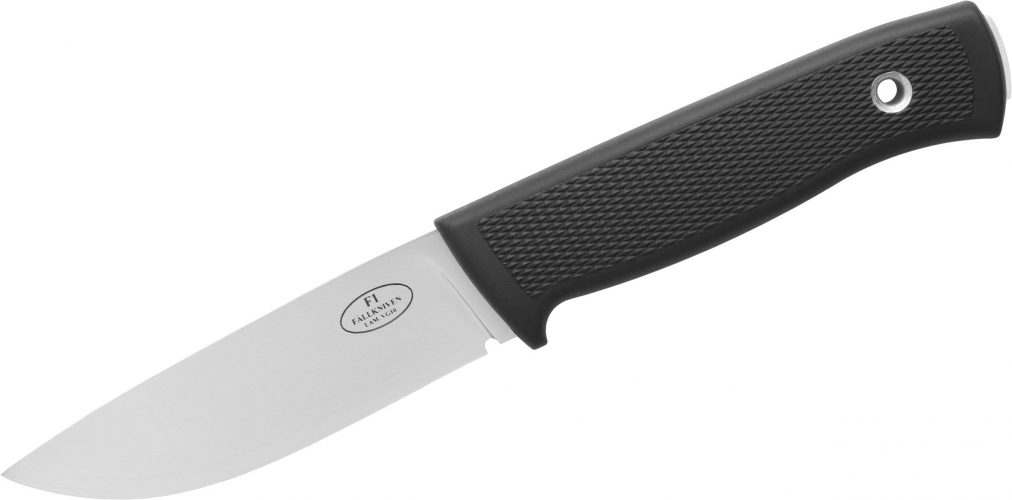
Steel: Lam.VG10
Length: 8.30 in
Weight: 5.30 oz
| Steel: | Lam.VG10 |
| Blade Length (in): | 3.75 |
| Blade Thickness (mm): | 4.57 |
| Overall Length (in): | 8.30 |
| Overall Weight (oz) | 5.30 |
| Blade Shape: | Drop Point |
| Grind: | Convex |
| Edge: | Plain |
| Hardness (HRC): | 59-62 |
| Handle Material: | Thermoplastic Elastomer |
| Protruding Pommel: | Yes |
| Lanyard Hole: | Yes |
| Sheath: | Zytel |
Yes, this is the second Fallkniven on the list. I like them. There, I said it. Fight me. Not unlike its bigger sibling, the A1, the beauty and the appeal in the Fallkniven F1 lie in its simplicity. Designed in Sweden and manufactured in Japan, the F1 has been the official survival knife of the Swedish Airforce since 1995.
The knife is 8.3 inches from tip to pommel and weighs 5.3 oz. The F1 is the smallest knife on our list, but it punches way above its weight.
The Blade
The blade of the Fallkniven F1 is made of laminated VG10 steel. Laminated steels aren’t everyone’s favorite, but VG10 is durable, hard, holds an edge well, yet is not too hard to maintain and sharpen. The F1 is a full tang knife with a plain edge, drop point and a Convex grind. The entire blade length is 3.75”, and it’s 4.57mm thick – that’s beefier than the Benchmark Buskcrafter and the Morakniv Survival Knife above.
Like the rest of the knife, the blade is understated but just screams of good design and quality engineering. Ther’s a small sharpening choil, and the back finishes at a 90-degree flat angle.
The Handle
The handle on the Fallkniven F is made from Thermoplastic Elastomer, a plastic polymer. Smooth at the top and bottom ends, it has diamond-shaped scales on the sides. Thermoplastic performs exceptionally under cold weather conditions (no surprises there) and retains its grip with almost no notable loss of control even when soaking wet. If there’s a chance your plane might go down in some snowy, wet area with sub-zero temperatures, this is the kife you want with you.
Even though this is a small knife, the handle and blade are well-balanced, and the knife is easy to work with or without gloves.
The Sheath
The sheath is, again, like the rest of the knife, understated, simple but effective. It is made from Zytel plastic with a nylon strap and a metal clip that holds the knife firmly and securely in place until you need them. There are leather sheaths available for the F1, though they seem to be becoming scarcer. If you can find one, I think leather just rounds this knife off very elegantly.
Conclusion
If you’re considering buying a survival knife and like your fixed blade knives more agile and on the smaller side, then I honestly think this is where you top searching. Buy the F1. You won’t regret it. It is an extremely capable survival tool, and of course, due to its smaller form-factor, it is an exceptional bushcraft tool.
Buying a Survival Knife – The Ultimate Guide
Although it seems hard to believe, there was a time when there was no such thing as a “survival knife”. Instead, large pattern Bowie knives and other large, ethnic pattern, knives such as the Hudson Bay knife, the Green River Knife, the Enep, the Barong, the Bolo, and the Parang were all termed “woodsman’s” knives or, were sometimes called “camp knives”.
Thus, when the term “survival knife” first became prominent in knife nomenclature, it was commonly associated with knives that had large, clip point, Bowie style blades with round, knurled, hollow steel tubes for handles with threaded butt caps that enabled access to the compartment inside of the handle. However, now that the art of wilderness survival has evolved from an obscure, arcane, art practiced only by Mountain Men, trappers, and intrepid explorers to one practiced by a wide range of outdoor enthusiasts for a multitude of purposes so too has the concept of a “survival knife”.
A survival knife may be part of a survival kit that includes various tools; such as an axe, saw, and multiple knives to give you a larger option for brush clearance and chopping and a smaller option for food prep and camp craft. Alternatively, a survival knife might be a so-called ‘one tool option’ and need to be large and robust enough to perform some of the tasks normally expected of a tomahawk or an axe while still being useful for smaller tasks.
Some key features to consider no matter what size of survival knife you decide best suits your needs include:
Fixed or Folding Blade
There is a saying that the best survival knife is the one you have on you, while that is true and any knife is certainly better than none, it is not necessarily true that the knife you have on you is the best survival knife. It might be the best that you have to hand but if all you have on you is a folding Opinell pocket knife you will not be able to attempt tasks that a more robust knife would allow you to perform.
A folder might be more discreet than a fixed blade, and most places allow the legal carry of folding knives of one description or another and you are therefore almost guaranteed the opportunity to have a pocket knife on you if an emergency was to arise. In your search for a robust survival knife though you should be looking for a fixed blade knife that provides the necessary strength for hard use.
While they are more convenient, and legal, folders are inherently weaker than fixed blades and for this reason, a survival knife always needs to be a fixed blade knife to provide a strong tool for any task and inspire confidence in your tool. Folding knives are inherently weaker than their fixed blade counterparts and there is always a risk that they will fail and fold up on your hand or fingers, or that the knife will break at the hinge. These weaknesses and the slight flexibility of all but the very strongest folding knives do not allow confident use and make tasks much more difficult. So always go for a fixed blade for your survival knife.
There are many places that will not allow the legal carry of fixed blade knives in a public place, this means that you often won’t be able to have your survival knife of choice on you at all times although there are smaller fixed blade options that are more discreet and which might be suitable for every day carry. Larger knives are still often a better choice, especially if you want a ‘one tool option’ but they may need to be included in a survival kit which you can grab in an emergency rather than being strapped to your thigh all the time.
Tang
The tang is the metal portion of the knife that extends from the blade into the handle of the knife, a survival knife must be robust and able to withstand anything you throw at it so it needs a tang that extends the whole length of the handle. Many would argue that a true full tang extends the whole width of the handle too and instead of the handle being fastened in one piece around the tang the handle is fastened in two pieces sandwiching the tang between the handle slabs.
There is certainly nothing wrong with this type of handle but my personal preference is for a full-length tang that is not full width so the handle can be of one piece. I prefer this because I often use my knife in cold conditions and prefer that my hand isn’t chilled by coming into contact with the steel while I work. A narrow tang is insignificantly weaker than a full-width tang as long as it goes the full length of the handle and will be perfectly robust enough for survival tasks.
A few popular knives used for survival are not full tang but these are in the significant minority although they are very popular and when their limitations are respected they perform excellently. They are of course the Mora range of knives, although they do now also produce the full tang Garberg model.
As a general rule though you should pick a survival knife that has a full tang, at least one which extends the whole length of the handle if not the full width.
Blade Steel
There is often fierce debate about which blade steel is best for a survival knife, ultimately it’s the qualities of the steel that are important rather than the kind of steel. If you are unfamiliar with the topic, check out our Beginners Guide to Blade Steel. There are lots of myths that stainless steel can’t be used to strike sparks from a ferrocerium rod and that carbon steels are easier to sharpen and somehow superior for bushcraft and survival knives. Neither of these things is necessarily true and instead of getting carried away with the type of steel instead focus on a few characteristics of the steel as you make your choice of knife.
Edge Retention
This refers to how well a knife holds its edge, you want a knife that will not become blunt after only gentle use. This needs to be balanced against the need for a knife to still be relatively easy to sharpen and toughness, ie; a blade that is not brittle. Very hard blades may keep their edge a long time but they may also be brittle and might chip or crack if they are abused.
The ‘hardness’ of a blade is measured on the Rockwell Scale, which measures hardness by applying first a small load and then a larger load to the steel and measuring the difference between the indentations. When testing knife steel the Rockwell hardness is denoted by the letters ‘HRC’ and the indentations are made with a 120° spheroconical diamond indenter.
Knives will generally have an HRC of between 55 and 65, the higher the number the harder the steel, but my recommendation for a survival knife is the 58-60 range. Much harder than that and although the edge will be very hard and won’t dull quickly it will be more likely to chip under hard use. Much softer and rather than chipping it may roll and blunt very quickly. Knowing the Rockwell hardness of a knife is important so you can pick a knife that is in this ‘sweet spot’ to avoid picking a knife that blunts too fast and or is too hard to sharpen in the field or that is so hard it chips.
Ease of Sharpening
Remember that although sharpening at home using large bench stones is relatively easy even with hard steels you will be maintaining the edge of a survival knife in the field with easily portable sharpening equipment such as a Fällkniven CC4 sharpening stone or a Lansky BladeMedic or even an improvised sharpener, so selecting a knife that is not too hard is important.
‘Hardness’
If a knife is too soft it will blunt more quickly and mean that you have to sharpen it too often. A knife that is too hard may be brittle and although the edge will stay sharp for a long time it might chip, a chipped blade is much more difficult to repair than a blunt blade as the edge of a blunt or rolled blade can quickly be realigned and sharpened, even with basic equipment in the field while a chipped blade has to be ground down to remove the chips and re-sharpened from there. While you do need to select a knife that is robust and which carefully treads that line between having good edge retention and being easy to sharpen the grind of a knife is an important contributing factor in this too.
With these factors considered you can make your choice of blade steel but remember that most blade steels used by reputable manufacturers will be absolutely fine in a survival knife as long as the criteria for hardness, ease of sharpening, and edge retention have been met. I have a few favorite steels for knives but can recommend any of the following blade steels;
- O1 tool steel
- N690Co steel
- D2 tool steel
- VG10
- Sandvick stainless or carbon steel
- 440C stainless steel
- A2 tools steel
- 1095 chromium-vanadium steel
- S30V
- Niolox
Although visually you can’t tell anything about the heat treatment from looking at a knife it is important that your survival knife has been properly heat treated. Heat treatment or tempering is the process of hardening the steel of a blade and removing the brittleness, steel is often annealed (softened by heating and allowing it to cool very slowly) to be ground to shape and then hardened once finished. This hardening process should bring the blade to a condition where it is strong but not brittle.
Some blades have what is called a differential heat treat, where the edge of the blade is harder than the spine so the edge can be very sharp with good edge retention while the spine is a little softer and more forgiving to allow the knife to stand up to more abuse. Most makers will temper a blade so the tang is softer than the handle so the tang is less likely to break when the knife is abused.
Some knife manufacturers will provide details of the heat treatment of their knives, TOPS for example often mention the differential heat treat of their blades, and ESEE knives are made by a company called Rowen Manufacturing who are so proud of their heat treat, quite rightly as they are excellent, and assembly of ESEE knives that their name is etched on the blades.
Grind
The grind of a knife blade is the cross-sectional shape of the edge, the way that the blade steel bevels towards the edge of the blade, to fully understand this you need to understand the anatomy of a knife.

The bevel of a knife is the part of the knife blade that slopes from the flat part of the blade to the sharp edge. The knife pictured above has what is called a Scandinavian grind or scandi-grind, which is a single angle normally starting anywhere from a quarter to a third of the way up the blade to the edge. This grind is preferred for working wood and is often found on specialist wood carving knives and light use bushcraft knives.
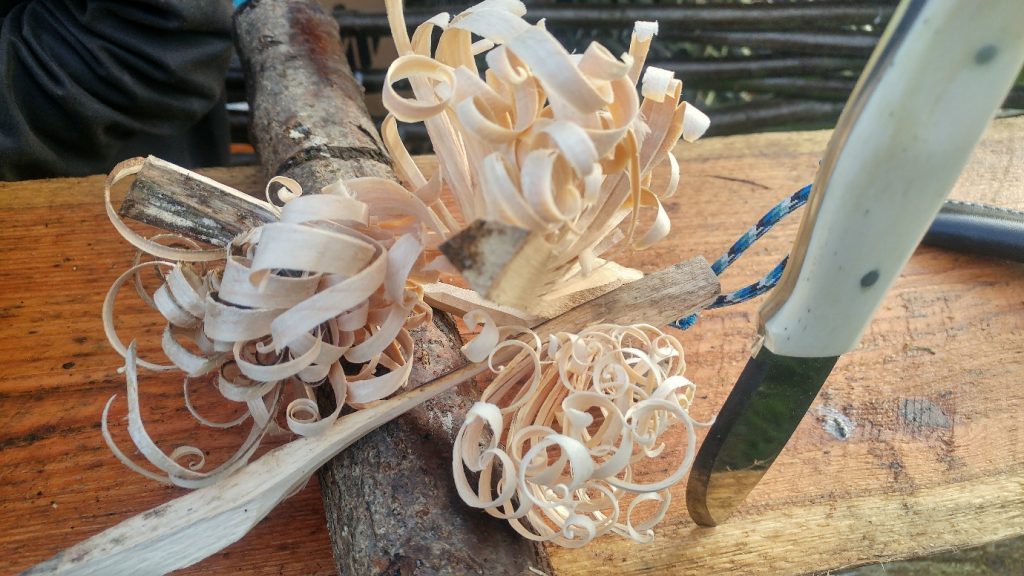
Other popular knife grinds which you might find on a survival knife are the sabre grind, convex grind, hollow grind, and full flat grind. Most of these feature what is normally referred to as a secondary bevel or a secondary ‘v’ edge. These secondary edges are added for strength and sometimes a secondary edge is even added to a scandi-grind as they can be fragile if they are abused.
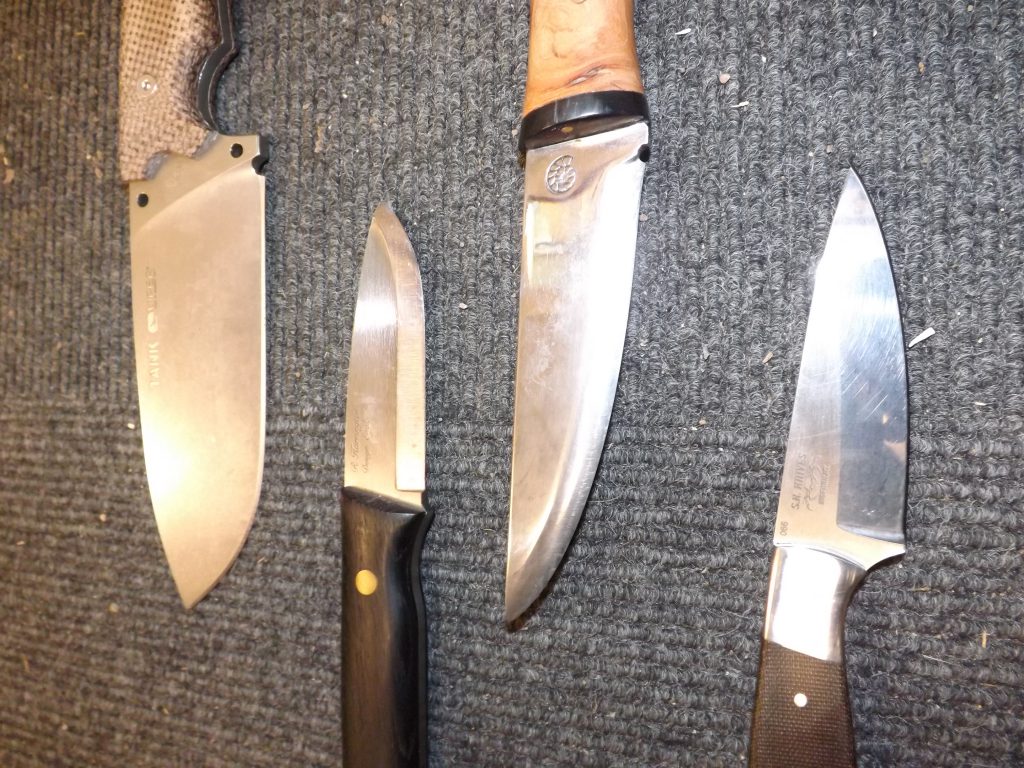
A sabre grind features a flat portion of the blade before the first bevel begins and then a secondary bevel at the edge for strength, this secondary bevel is important on a sabre ground knife as a Casström Roger Harrington design woods knife rind starting that high would be too thin and fragile if it went directly to a sharp edge like a scandi-grind.
A full flat grind has no flat portion and instead bevels all the way from the spine to a final secondary bevel at the edge. I like a flat grind for carving and woodwork but for survival tasks, it is not as good as a sabre or scandi-grind for splitting wood apart with a baton for kindling.
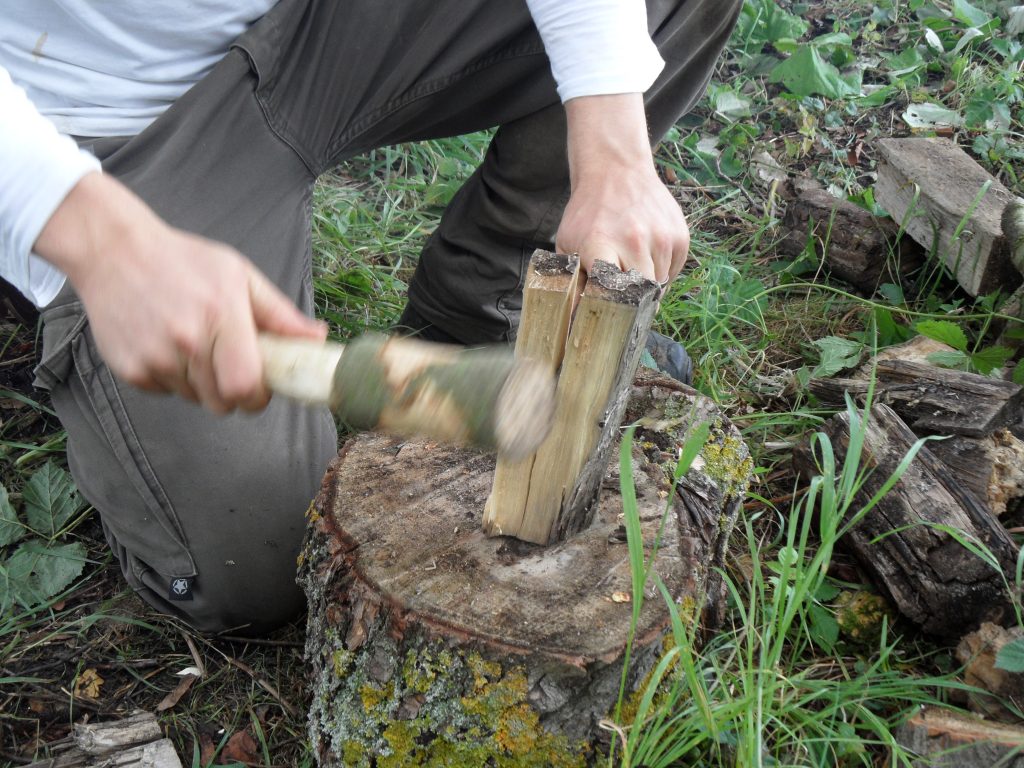
The slightly steeper angle and flat portions on the blade of a scandi or sabre ground blade act as a better wedge for splitting wood. Be aware if you are going to use your knife in this manner though that it really is an abuse of your knife, although modern knives are strong enough for the task an axe is really the tool for the job.
Covex ground blades are some of the strongest grinds available as they are basically two curves starting at the spine and meeting at the edge. The shape of this grind means that there is a greater thickness of metal behind the edge than on the finer edges of some of the other grinds. This makes a convex ground knife extremely strong and less likely to chip or blunt even after heavy use. For this reason, convex grinds are often chosen for knives designed for chopping.
Convex grinds are however difficult to produce to a high standard and I wouldn’t rust all manufacturers when it comes to convex grinds, you are safe with Fällkniven and Bark River when it comes to convex grinds though. Because convex grinds are so robust they can be tempered to a higher Rockwell hardness without too much risk of them chipping or breaking.
Hollow grinds are featured on a very few survival knives, normally budget knives, and while these grinds are excellent for some tasks, particularly slicing and processing meat they are not very robust. A hollow grind should have a secondary bevel on the edge to make it stronger but it still has less metal behind the edge than any of the other grind options making it less robust for heavy tasks such as chopping or batoning. Because of its relative fragility, hollow ground blades should not be tempered to an excessive Rockwell hardness to avoid chipping the relatively fragile edge.
There are a few other grinds styles but they are very specialist and I’m not aware of any production survival knives which feature any of these more unusual grinds such as chisel grinds or asymmetric grinds such as the ‘yakut’ style grind from Russia which features a convex grind on one side and a flat grind with a large fuller on the other.
Blade Style
While grind is an important consideration when you select your survival knife blade style is less important, not irrelevant but less important than other factors. Much of it is down to personal preference although there are a few useful features to look for in a blade;
Ricasso
The ricasso is an unsharpened portion of the blade between the handle and the edge, I prefer that this is as small as possible or even better completely omitted from my knives. It puts distance between your hand and the sharp edge of the knife and reduces the control that you have over the blade for fine carving and meat processing work.
Choil

A choil is a notch between the blade edge and ricasso or handle, the primary reason for this is to allow the edge of the blade to be sharpened along its entire length. An edge that starts directly from the ricasso or handle is impossible to sharpen because you can’t reach that last portion of the blade with a sharpening stone. A sharpening choil takes away that problem and is a very useful feature to look for in a knife.
Some knives feature an oversized choil large enough for your index finger, the idea behind this feature is to move the weight of the cutting edge out to the front of the knife and allow you to have a full grip on the handle for chopping while allowing you to coke up on the blade and bring you hand closer to the edge using the finger choil for finer work.

Finger choils have become quite popular on larger knives but I personally wouldn’t recommend them, they bring your finger too close to the edge of the blade and are generally very uncomfortable to hold. The reason for having a handle on a knife is to allow you to grip it comfortably and use it for long periods of time, bringing your hand forward onto a section of the knife without a handle for finer work such as carving and making feather sticks is very uncomfortable.
Serrations
Serrations are featured on some knives and while they do present advantages for cutting rope their uses other than that are fairly limited. They are also difficult to sharpen and useless when it comes to working wood or processing game and food, two particularly important tasks in a survival situation.
Blade Shape
There is a multitude of blade shapes to choose from but a few are particularly useful for a survival knife. Drop point, spear point, clip point, and strait-backed blades are the most common types featured on survival knives. Other blade shapes such as wharcliffe, tanto, and trailing point blades are useful for the tasks they were designed for but are fairly specialist and don’t feature on any popular survival knives. Another aspect of blade shape to consider is the angle of the spine of the blade, some knives feature nicely rounded, smooth, aesthetically pleasing spines but this is not always a desirable feature, a sharp 90°spine is sometimes useful for scraping things, either to produce fine shavings of wood or bark for fire lighting and to strike sparks from a ferrocerium rod.
Another feature of the spine of a knife is often something called ‘jimping’ or ‘knurling’, which is texturing which potentially provides a better grip on the blade. While it does provide better grip when holding the knife in some positions it can also cause discomfort if it is too heavily textured.
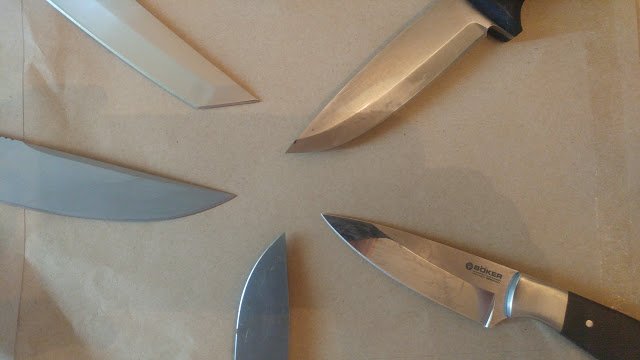
Handle Material
Above all a knife handle must be comfortable and strong, popular materials include micarta which is a composite material made of fabric saturated with epoxy resin and then hardened, it can be made from a range of materials but popular options include canvas, linen, and paper. G10 is a similar material that uses fiberglass as a base material. These modern handle materials have become at least as popular as traditional wood and bone handles and offer significant advantages in certain areas, particularly in that they are non-absorbent so they don’t soak up moisture, blood, or other contaminants.
Wood has been ‘modernized’ in recent years though and is often stabilized with resin and cured in a kiln which makes it as hard and impermeable as micarta and G10.
Other knife handle materials include various plastic and rubber compounds which offer great grip and are impervious to moisture. Traditional antler and bone handles are of course still an option but bone can be fragile and sometimes the texture of an antler handle can be uncomfortable. A few knives have metal handles which are very robust but can be very uncomfortable to use in the cold.
Sheath
A sheath is a part of the ‘package’ when you buy a knife and you will need to consider the best option for your survival knife, either because you want to pick a knife that comes with a good sheath or because you may need to consider having an alternative sheath made for a knife with an unsuitable sheath. Leather is the traditional choice but does absorb moisture and can retain water and promote rusting of some blades if they are stored in a wet sheath.
Plastics such as Kydex are a great modern option that can be formed and fitted to a blade and which provide safe and moisture resistant storage for your knife. Nylon sheaths are very hit and miss, some are excellent but others are very poor and offer no security in retaining the knife in its sheath, others are sloppily secured with Velcro and are noisy or are much too large for the knife.
I would always recommend leather or Kydex for a good sheath but with the qualifier that a knife intended primarily for hunting and meat processing has a plastic sheath so it can be properly sanitized and cleaned after use. Leather can harbor bacteria but for a survival knife where game preparation will be a small part of its job, this is not so important.

From top to bottom:
- CRKT Saker: Walnut handle, leather sheath, high Scandinavian grind, 1095 carbon steel blade and spear point.
- Eickhorn Nordic Bushcraft Knife; Aluminium handle, leather sheath, full flat grind, Bähler N695 steel and clip point.
- Handmade Bushcraft Knife: Bone handle, leather sheath, standard scandi-grind, O1 steel and drop point.
- Camilus Bushcraft Knife; micarta handle, leather sheath, standard scandi-grind, 1095 steel and ‘nessmuk’ style modified trailing point blade.
- TOPS C.U.B; micarta handle, featuring a divot for bow drill fire lighting, nylon sheath (an example of a very bad nylon sheath), scandi-grind with secondary bevel, 1095 steel and clip point.
- Real Steel Bushcraft Knife; Micarta handle, kydex sheath, standard scandi-grind, D2 steel, drop point blade.
- EKA W12 Knife; G10 handle, kydex and leather sheath, scandi-grind with secondary bevel, drop point blade.
- Mora Companion; plastic handle, plastic sheath, scandi-grind, Sandvik stainless steel, slight clip point.
- Steel Will 205 Mini Druid; Rubberised plastic handle, leather sheath, sabre grind, 9Cr18MoV stainless steel, clip point.
Blade Size
There are different schools of thought when it comes to the size of your survival knife, between four and six inches is commonly accepted as a good size. Some would disagree and say that survival knives don’t start below six inches and that the larger knives are a definite requirement so they can be used for splitting larger logs for firewood and for heavy-duty chopping tasks. My preference is for a knife around four inches in length which is more nimble and useful for fine tasks and I would either select the material of the right size for the smaller knife and couple it with an axe and saw for heavier work.
Blades much shorter than four inches are generally not large enough to be versatile survival knives, another dimension to consider is the thickness of a blade as well as its length, although blades designed for skinning game, and filleting fish are designed to be thin, this is particularly important in a filleting knife as a degree of flexibility is desirable but a good survival knife will need a robust blade and I would recommend a thickness of at least 3mm and if you are planning on doing much batoning with it 4mm is preferable. Blade thickness is also often measured in fractions of an inch with some very robust blades featuring 1/4inch (6.35mm) thick blades.
As long as you use a knife within its design capabilities though the thickness is less important, Mora Companions are among the most popular knives in the world and feature blades of about 2mm in thickness and are capable of a wide range of tasks and are very useful knives for survival.
Blade Coatings
Some manufacturers coat their blades, there are a number of reasons for this generally, blades for tactical applications are often coated, blued, or blackened to avoid reflection in a situation where that glare might give away your presence. Some survival knives are designed with escape and evasion and military applications in mind and so do have a non-reflective coating, generally, though your priority in a survival situation is to be found and rescued so unless you are a member of the armed forces and are looking for a survival knife you probably don’t need a non-reflective coating.
Another reason to coat a blade is to prevent rust and corrosion, some blade steels such as 1095 are very susceptible to rust and might benefit from a coating to prevent this. However, very rough coatings especially if they come all the way to an edge can really hamper the ability of a knife to carve and slice and I prefer not to have them at all. Stainless steel blades suffer less from rust, although they aren’t immune to it, even a carbon steel blade if properly maintained can be kept free of rust with regular use and proper care including oiling it and sharpening it. So from a maintenance perspective coatings are not vital but often useful to prevent rust.
Lanyards
I use a lanyard to keep my pocket knife from being lost if it drops out of my pocket, a lot of fixed blade knives also have a hole in the handle for a lanyard but I tend not to make use of this feature unless I am carrying a knife in a very deep carry sheath and then I add a small lanyard to help me grip the knife and draw it. I don’t like wrist loop lanyards, people often use them when they are chopping with larger knives so the knife doesn’t fly off if it slips out of their hand or to give a bit of extra purchase on a knife if they are gripping the back of the handle for more effective chopping. The danger of this is that if a knife does fly out of your hand and is attached to your wrist it will bounce back and swing around, potentially with some force, and probably injure you.

Conclusion
This one-tool approach to survival is quite popular nowadays and many knives are marketed as a one-tool solution to a survival situation. However in a real emergency, unless you carry your knife with you at all times, you are no more likely to have your survival knife on you than you are an entire survival kit.
Yet, the philosophy of a one tool option, and the assumption that you will have that tool on you when you really need it, is somewhat flawed. For this reason, it is just as important to consider smaller survival knives that you are more likely to have on you at all times compared to larger knives which might be too heavy, uncomfortable, or illegal to carry with you as a matter of routine.
Geoff has a background as a professional game and deer manager. He has put his years of experience to good use and now lectures at Hartpury College, one of the UK’s leading providers of land-based education.
He specializes in training game and wildlife managers who will work in professional game management, conservation, and other outdoor professions. He's been teaching at colleges for eight years and, in that time, has worked at some of the most prestigious land-based colleges in Britain.






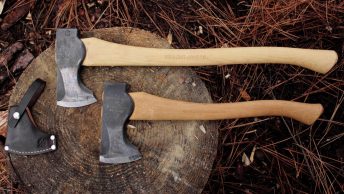
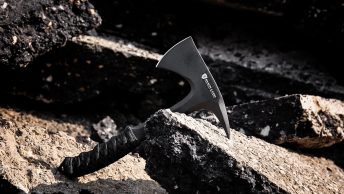
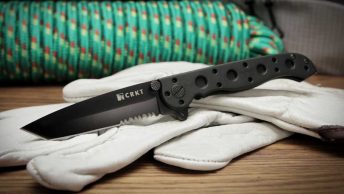
I’m certain it’s not the ‘best’ knife, but my favorite for general field use has been the Gerber Strongarm. It has batoned through hundreds of logs, smashed rock with the pommel, been thrown, made all sorts of improvised campsite gear, and just been the general go-to for all sorts of abusive work. It doesn’t hold the best edge, but it sharpens easily in the field, and stays put in your hand, which counts for a lot. The coating on my blade has lost a lot of coverage (but added a lot character), but it’s nothing some mineral oil can’t handle.
I own Mora Kansbol. Superb quality, sharp, reliable, reasonable price.
Liked your article but one very important feature that wasn’t discussed was a full tang blade design. This however is not absolutely required but highly desirable for overall strength. Although not a fan of the Gerber brand the Strong Arm s a capable knife but on the smaller side. You named many that I do own and love the Tops Silent Hero is one of my top picks.
John – we actually discuss tangs throughout the article and specifically in the buyers guide. A full tang is pretty much a must-have feature from our perspective when it comes to survival knives.